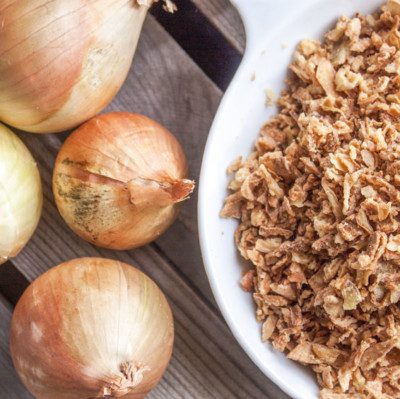Origin
The genus Allium is the most diverse in the Mediterranean region. However, China and India are the largest onion-producing countries in the world. Generally speaking, onions require cool climates and are best grown in high altitude regions. They are available in various sizes, colors (white to red) and total soluble solids (TSS).2
Although some are perennials, they are mainly cultivated as a biennial. They are propagated by seeds, bulbs or sets. Although an onion grows underground, it is not a root tuber. It is the shoot portion that is developed to store nutrients for the plant.1,2
Function
Onions may have several functions in baked goods:
- Flavor and aroma: provide a distinctive pungent, sweet flavor due to various sulphur-containing amino acid derivatives and aromatic structures. Most notable aroma compounds are isothiocyanates, monosulfides, disulfides, and trisulfides.2,3,4
- Antimicrobial agent: antimicrobial actives in onions mainly allicin (diallyl thiosulfinate:thio-2-propene-1-sulfanilic acid-5-allyl ester) can inhibit growth and production of toxins by many bacterial pathogens. Other stable antimicrobial components in onions include the flavonols, quercetin and kaempferol, shown to inhibit DNA, RNA and protein biosynthesis.5,6
- Antifungal and anti-yeast: inhibits the growth of yeast and fungi due to the presence of organosulfur containing compounds.
- Antioxidant: onion flavonoids, specially quercetin and its glycosides have a high radical scavenging activity. Onion’s antioxidant capacity depends on variety. For example, red and yellow varietiespossess higher concentrations of antioxidants than white onion.
Application
Onions can be used in virtually any meal. They can be used in meats, sauces, soups and dips and baked products.
Considerations when adding them to bread formulations:
- Fried or powdered onions can be mixed into the dough with no significant impact on gluten development.
- Onion rings or coarsely minced forms are usually used as toppings.
- Given their antimicrobial activity, more yeast may be needed for proper product volume.
- Switching from fresh to dry forms should be carried out based on total solids content, since fresh onions contain 90% water and the flavors/actives are found in the dry portion.
- Powdered onion goes well with ground caraway and dill seeds. Rye and pumpernickel bread can be prepared using these three ingredients.
- Given onions’ activity against several microorganisms, bakers may need to add more yeast to ensure proper volume development.
- Crispy fried pieces can not only add flavor, but also add a visual aspect to baked goods.
Commercially available forms of onions
Onions are sold locally in whole or fresh form. Shelf-stable forms are processed in variety of ways. Also, the ingredient can be frozen, canned, or pickled in vinegar or brine. If they are dehydrated, the white varieties with high total soluble solids are most often used.
The following commercial forms are available for use in the baking industry:
- Dehydrated
- Freeze-dried
- Fried
- Fresh
Onions are dehydrated as flakes, coarsely minced, rings or powder. The food industry requires white onion varieties with the following attributes:1
- Total soluble solids (>20%)
- High degree of pungency
- High insoluble solids
- Low reducing to non-reducing sugars ratio to avoid caramelization
- High crop yields
- Good storage quality
Dehydration process using forced air
Onion powder is commercially produced by the following process:1
- Harvesting, sizing
- Washing with water and a chlorine solution
- Peeling and slicing
- Drying: three stage drying with hot air at 75°C (167°F), 65°C (149°F) and 55-60°C (131-140°F).
- Bin drying: powder is placed in bins until it reaches a final moisture (~4%)
- Screening, aspirating and grinding
Nutrition
The chemical composition of onions varies with season, variety and age:
| Component | g / 100 g onion |
| Moisture | 88.0–93.0 |
| Protein | 0.9–1.6 |
| Fat | Trace–0.2 |
| Total carbohydrates | 5.2–9.0 |
| Ash | 0.5–0.6 |
| Energy | 23–38 cal / 100 g |
Fresh onions are a good source of flavonoids (270 – 1917 mg/kg), mainly quercetin and kaempferol, known to have anti-inflammatory, antiallergenic, vasodilatory and anti carcinogenic properties.6
Regulations
Onion and onion products are classified by the FDA as GRAS. When used in foods, powdered and granulated onion should be listed on the product label.7
In the European Union, the onion market is regulated by the EC Regulation No 1508/2001. This regulation establishes the quality standards and classifications on onions.
References
- Lawande, K.E. “Onion.” Handbook of Herbs and Spices, 2nd edition, Woodhead Publishing Limited, 2012, pp. 417–429.
- Attokaran, M. “Onion.” Natural Food Flavors and Colorants, 2nd edition, John Wiley & Sons Ltd, 2017, pp. 294–297.
- De Rovira, D. Dictionary of Flavors, 3rd edition, John Wiley & Sons Ltd, 2017, p. 23, 214.
- Ziegler, H. Flavourings. Production, Composition, Applications, Regulations, WILEY-VCH Verlag GmbH & Co. KGaA, 2007, p. 237.
- Davidson, P.M., and Bozkurt Cekmer, H. “The Use of Natural Antimicrobials in Food: An Overview.” Handbook of Natural Antimicrobials for Food Safety and Quality, Woodhead Publishing, Elsevier Ltd., 2015, pp. 1–9.
- Santas, J, Almajano- Pablos, M.P and Carbó-Moliner, R. “Onion, a natural alternative to artificial food preservatives. Review.” Agro food industry hi-tech 21.5 (2010): 44-46.
- Food and Drug Administration (FDA). US Department of Health and Human Services. CFR Code of Federal Regulations Title 21, Part 101 Food Labeling, https://www.accessdata.fda.gov/scripts/cdrh/cfdocs/cfcfr/cfrsearch.cfm?fr=101.22, Accessed 21 August 2020.
- European Commission (EC). Commission Regulation 1508/01/EC laying down the marketing standard for onions and amendingRegulation (EEC) No 2213/83. Official Journal of European Communities, 24 July 2001.

